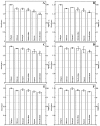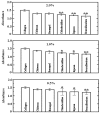HaCaT Keratinocytes Response on Antimicrobial Atelocollagen Substrates: Extent of Cytotoxicity, Cell Viability and Proliferation
- PMID: 24956439
- PMCID: PMC4099973
- DOI: 10.3390/jfb5020043
HaCaT Keratinocytes Response on Antimicrobial Atelocollagen Substrates: Extent of Cytotoxicity, Cell Viability and Proliferation
Abstract
The effective and widely tested biocides: Benzalkonium chloride, bronopol, chitosan, chlorhexidine and irgasan were added in different concentrations to atelocollagen matrices. In order to assess how these antibacterial agents influence keratinocytes cell growth, cell viability and proliferation were determined by using MTT assay. Acquired data indicated a low toxicity by employing any of these chemical substances. Furthermore, cell viability and proliferation were comparatively similar to the samples where there were no biocides. It means that regardless of the agent, collagen-cell-attachment properties are not drastically affected by the incorporation of those biocides into the substrate. Therefore, these findings suggest that these atelocollagen substrates enhanced by the addition of one or more of these agents may render effectiveness against bacterial stains and biofilm formation, being the samples referred to herein as "antimicrobial substrates" a promising view in the design of novel antimicrobial biomaterials potentially suitable for tissue engineering applications.
Figures






Similar articles
-
Characterization of ionic liquid cytotoxicity mechanisms in human keratinocytes compared with conventional biocides.Chemosphere. 2021 May;270:129432. doi: 10.1016/j.chemosphere.2020.129432. Epub 2020 Dec 31. Chemosphere. 2021. PMID: 33422997
-
Sponge-like processed D-periodic self-assembled atelocollagen supports bone formation in vivo.Mater Sci Eng C Mater Biol Appl. 2021 Jan;120:111679. doi: 10.1016/j.msec.2020.111679. Epub 2020 Oct 27. Mater Sci Eng C Mater Biol Appl. 2021. PMID: 33545841
-
Cell proliferation of HaCaT keratinocytes on collagen films modified by argon plasma treatment.Molecules. 2010 Apr 20;15(4):2845-56. doi: 10.3390/molecules15042845. Molecules. 2010. PMID: 20428083 Free PMC article.
-
Influence of cyclodextrins on the proliferation of HaCaT keratinocytes in vitro.J Biomed Mater Res A. 2007 Oct;83(1):70-9. doi: 10.1002/jbm.a.31195. J Biomed Mater Res A. 2007. PMID: 17380497
-
Biological Synergy and Antimicrobial Mechanism of Hydroxypropyltrimethyl Ammonium Chloride Chitosan with Benzalkonium Chloride.Chem Pharm Bull (Tokyo). 2021;69(7):612-619. doi: 10.1248/cpb.c20-00995. Chem Pharm Bull (Tokyo). 2021. PMID: 34193710
Cited by
-
Development of Nanoemulsions for Wound Dressings Containing Cassia alata L. Leaf Extraction.Evid Based Complement Alternat Med. 2022 Oct 11;2022:4282678. doi: 10.1155/2022/4282678. eCollection 2022. Evid Based Complement Alternat Med. 2022. PMID: 36267084 Free PMC article.
-
Streptomyces monashensis MSK03-mediated synthesis of gold nanoparticles: characterization and antibacterial activity.RSC Adv. 2024 Feb 5;14(7):4778-4787. doi: 10.1039/d3ra07555a. eCollection 2024 Jan 31. RSC Adv. 2024. PMID: 38318610 Free PMC article.
-
Fabrication and Impact of Fouling-Reducing Temperature-Responsive POEGMA Coatings with Embedded CaCO3 Nanoparticles on Different Cell Lines.Materials (Basel). 2021 Mar 15;14(6):1417. doi: 10.3390/ma14061417. Materials (Basel). 2021. PMID: 33804043 Free PMC article.
-
Upgrading Mitochondria-Targeting Peptide-Based Nanocomplexes for Zebrafish In Vivo Compatibility Assays.Pharmaceutics. 2024 Jul 20;16(7):961. doi: 10.3390/pharmaceutics16070961. Pharmaceutics. 2024. PMID: 39065658 Free PMC article.
-
Low-intensity pulsed ultrasound promotes proliferation and migration of HaCaT keratinocytes through the PI3K/AKT and JNK pathways.Braz J Med Biol Res. 2018 Oct 18;51(12):e7862. doi: 10.1590/1414-431X20187862. Braz J Med Biol Res. 2018. PMID: 30365726 Free PMC article.
References
-
- Parenteau-Bareil R., Gauvin R., Berthod F. Collagen-based biomaterials for tissue enginnering applications. Materials. 2010;3:1863–1887. doi: 10.3390/ma3031863. - DOI
-
- López-García J., Humpolíček P., Lehocký M., Junkar I., Mozetič M. Different source atelocollagen thin films: Preparation, process optimisation and its influence on the interaction with eukaryotic cells. Mater. Tehnol. 2013;47:473–479. doi: 10.1016/j.matdes.2012.12.069. - DOI
-
- Bernal A., Balková R., Kuřítka I., Sáha P. Preparation and characterisation of a new double-sided bio-artificial material prepared by casting of poly(vinyl alcohol) on collagen. Polym. Bull. 2012;70:431–453.
-
- Tanaka Y., Yamaoka H., Nishizawa S., Nagata S., Ogasawara T., Asawa Y., Fujihara Y., Takato T., Hoshi K. The optimization of porous polymeric scaffolds for chondrocyte/atelocollagen based tissue-engineered cartilage. Biomaterials. 2010;31:4506–4516. doi: 10.1016/j.biomaterials.2010.02.028. - DOI - PubMed
LinkOut - more resources
Full Text Sources
Other Literature Sources

